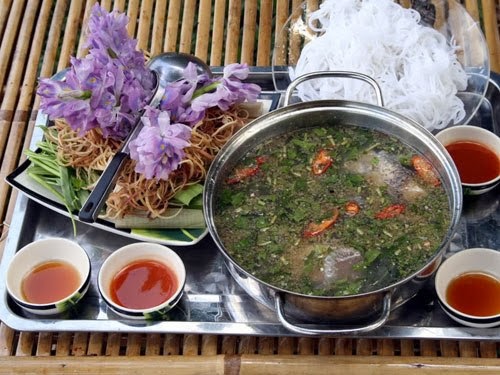It was a trip laden with nostalgia. I revisited
Phong Dien the other day with old friends I had not met since we graduated from
university more than 10 years ago.
All of us wanted to revive memories of camping trips we frequently took in the area when we were students.
Now a popular eco-tourism
destination in the Mekong Delta, Phong Dien has gone through many changes since
we saw it last.
But, overall, it is still
home to fruit gardens, simple yet tasty, homemade food, and vong co (southern traditional music whose name
is literally translated as “longing for the past”) songs.
Situated more than 16
kilometers south of Can Tho’s center, Phong Dien can be accessed through Road
No. 923, which starts at the foot of Cai Rang Bridge. The road is now asphalted
and no longer a rough path strewn with pebbles and stones, but along its sides,
the fruit gardens still stand.
As we drove along, we
were most impressed by clusters of dau
Ha Chau(literally Ha Chau berry), the specialty of Phong Dien.
According to some
accounts, the fruit was bred and developed by farmer Le Quang Minh in the
1960s. At that time the land’s most famous fruit, cam mat(a kind of orange that
has very small seeds and light yellow juice), was dying of a disease called
citrus vein phloem degeneration.
Looking like Burmese
grapes but rounder, with a thin skin and sweet and slightly sour flesh, dau Ha Chau soon gained popularity not only in
Vietnam, but also in Laos and Cambodia.
It is now planted across
Phong Dien and during its season, the fruit is practically everywhere, from
gardens to street stalls, with average prices at around VND20,000 per kilogram.
The fruit is a common souvenir for visitors to take back to their families and
friends.
We visited a local garden
to enjoy the grape, lying on hammocks and chatting away. We also had wines made
from local fruits like grapes and cocoa.
Someone played vong co on a disc player or a cassette player
afar, inspiring us to sing a couple of songs. But, none of us could do it as
well as a local. Public venues where people sing vong co with proper music bands are everywhere
in Phong Dien. Locals just love this music and sing the songs quite often and
so well that it is not an exaggeration to say that vong co is in their blood.
After spending half a day
in the garden, we headed out to enjoy the most famous local specialty, banh xeo (sizzling cake).
Compared to its cousin in
the central region, the deep-fried pancake in Phong Dien is much bigger. Its
middle part is soft thanks to the stuffing consisting of pork, shrimps, hulled
mung beans and bean sprouts. Meanwhile, the side with only rice flour is thin
and crispy.
Even though the cake is
fried in a considerable amount of oil, it does not taste oily at all when eaten
with a variety of leafy vegetables.
In fact, a good balance
is struck when we place a piece of banh
xeo on a big mustard leaf,
then add smaller leaves like mango, and finally dip it into nuoc mam (fish sauce mixed with vinegar or
lime, and sugar).
We also had a hotpot made
with salted ca linh (a fish species under the same family
with carps), numerous home-grown flowers like dien
dien(Sesbania sesban), sung (water lilies), and so dua (Agati grandiflora, or agati), and
different kinds of leafy vegetables.
Dien dien and ca linh are specialties of the floating season
in the Mekong Delta. Starting in the seventh month and ending in the tenth
month of the lunar calendar, the off-the-book season happens when more water
from the Mekong River flows into its tributaries in Vietnam – the Tien and Hau
rivers.
Later, we cycled along
local roads that were shaded by trees to enjoy the last pure breezes of the
countryside. As we left again for crowded and polluted Ho Chi Minh City, we all
agreed that, nostalgia or not, Phong Dien should be a frequent rendezvous for
us.
And Enjoying the best food:
 |
banh xeo (sizzling cake).
|

 |
| Dien Dien Flower and Ca Linh fish |













.jpg)









.jpg)

.jpg)

0 nhận xét: